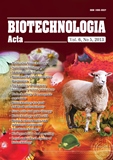ISSN 2410-776X (Online),
ISSN 2410-7751 (Print)

"Biotechnologia Acta" v. 6, no. 5, 2013
https://doi.org/10.15407/biotech6.05.094
Р. 94-99, Bibliography 16, Ukrainian
Universal Decimal classification: 57.088.5:66.091
DETECTION OF COMPLEXES OLIGODEOXYNUCLEOTIDES WITH POLYMERIC CARRIERS
V. V. Vlizlo1, S. Zaichenko2, L. A. Ivanytska1, 2, M. R. Kozak1, D. D. Ostapiv1
1Institute of Animal Biology of National Academe of Agrarian Sciences, Lviv, Ukraine
2National University «Lviv Polytechnic», Ukraine
The new method for detection of cationic oligoelectrolytes conjugates with oligodeoxyonucleotides, based on free diffusion of these substances in 0.8% agarose gels is developed. It enables to simplify and reduce the cost of visual identification of the best carrier among various polymer compounds and to uncover the fact of complex formation between the interacting agents resulting in formation of a ring precipitation. The universality of the proposed methodological approach is confirmed by interaction of coligodeoxynucleotides with other cationic polymer of natural origin, namely chitosan. Comparative analysis of our approach applicationto turbidimetry data concerning coligodeoxynucleotides complexes and their electrophoresis showed some advantages, among them are the ability to screen simultaneously a large number of polymeric carriers and no need for using of more expensive equipment and materials. To conclude the complexing occurrence it is enough nanomol amounts of oligodeoxynucleotide.
Key words: synthetic oligoelectrolytes, diffusion in gel, turbidimethry, electrophoresis of oligodeoxynucleotides.
© Palladin Institute of Biochemistry of National Academy of Sciences of Ukraine, 2013
References
1. Tuschl T., Zamore P. D., Lehmann R. Targeted mRNA degradation by double-stranded RNA in vitro. Genes Devel. 1999, V. 13, 3191–3197.
https://doi.org/10.1101/gad.13.24.3191
2. Vilgelm A. E., Chumakov S. P., Prassolov V. S. RNA interference: Biology and prospects of application in biomedicine and biotechnology. Mol. Biol. 2006, 40 (3), 339–354.
https://doi.org/10.1134/S0026893306030010
3. De Fran?a N. R., J?nior D. M., Lima A. B. RNA interference: A new alternative for rheumatic diseases therapy. Bras. J. Rheumatol. 2010, 50 (6), 695–709.
4. ?zbas-Turan S., Akbuga J., Sezer A. D. Topical application of antisense oligonucleotide-loaded chitosan nanoparticles to rats. Oligonucleotides. 2010, 20 (3), 147–153.
https://doi.org/10.1089/oli.2009.0222
5. Halama A., Kuli?ski M., Librowski T., Lochy?ski S. Polymer-based non-viral gene delivery as a concept for the treatment of cancer. Pharmacol. Rep. 2009, V. 61, P. 993–999.
https://doi.org/10.1016/S1734-1140(09)70160-4
6. Marshall E. Gene therapy death prompts review of adenovirus vector. Science. 1999, V. 286, P. 2244–2245.
https://doi.org/10.1126/science.286.5448.2244
7. Finiuk N., Bilyk O., Mitina N. Efficient DNA delivery to yeast cell by novel olygoelectrolyte nanopolymer carries. IV Polish-Ukrainian Weigl Conference «From microbiology to synthetic biology»: Institute of Immunology and Experimental Therapy, Wroclaw, May 18–20. 2011, 4 (1), 106.
8. Ivanytska L.A., Stadnyk V. V., Maior Kh. Ya., Vlizlo V. V. Content of physiological prion in L1210 cells for actions fosfortioatnyh antysens-olihodezoksynukleotydiv. Biol. tvaryn. 2011, 13 (1–2), 433–439. (In Ukrainian).
9. Ivanytska L.A., Stadnyk V. V., Martin Yu. V. An effective method for reducing expression of prions in vitro and in vivo by antysens-olihodezoksynukleotyds conjugated with a new oligoelectrolytes based on dymetylaminoetylmetakrylat. Biol. studii. 2011, 5 (3), 77–88. (In Ukrainian).
10. Zhang X., Ercelen S., Duportail G. Hydrophobically modified low molecular weight chitosans are efficient and nontoxic gene delivery vectors. J. Gene Med. 2008, V. 10, P. 527–539.
11. Lyalikov Yu. S. Physico-Chemical analysis methods. Ed. Fifth, rev. and add. Мoskva: Khimiya. 1974, 536 p. (In Russian).
12. Pikkering U. F. Modern analytical Chemistry: Translated from English. Мoskva. 1977, 560 p. (In Russian).
13. Sakurai H., Kawabata K., Sakurai F. Innate immune response induced by gene delivery vectors. Intern. J. Pharm. 2008, V. 354, P. 9–15.
14. Antibodies. Methods. Book. 1: Translated from English. Ed. D. Ketti. Мoskva: Mir. 1991, P. 201–207. (In Russian).
15. Bhuvaneshwari S., Sruthi D., Sivasubramanian V. Development and characterization of chitosan film. IJERA. 2011, 1 (2), 292–299.
16. Saranya N., Moorthi A., Saravanan S. Chitosan and its derivatives for gene delivery. Int. J. Biol. Macromol. 2011, 48 (2), 234–238.

